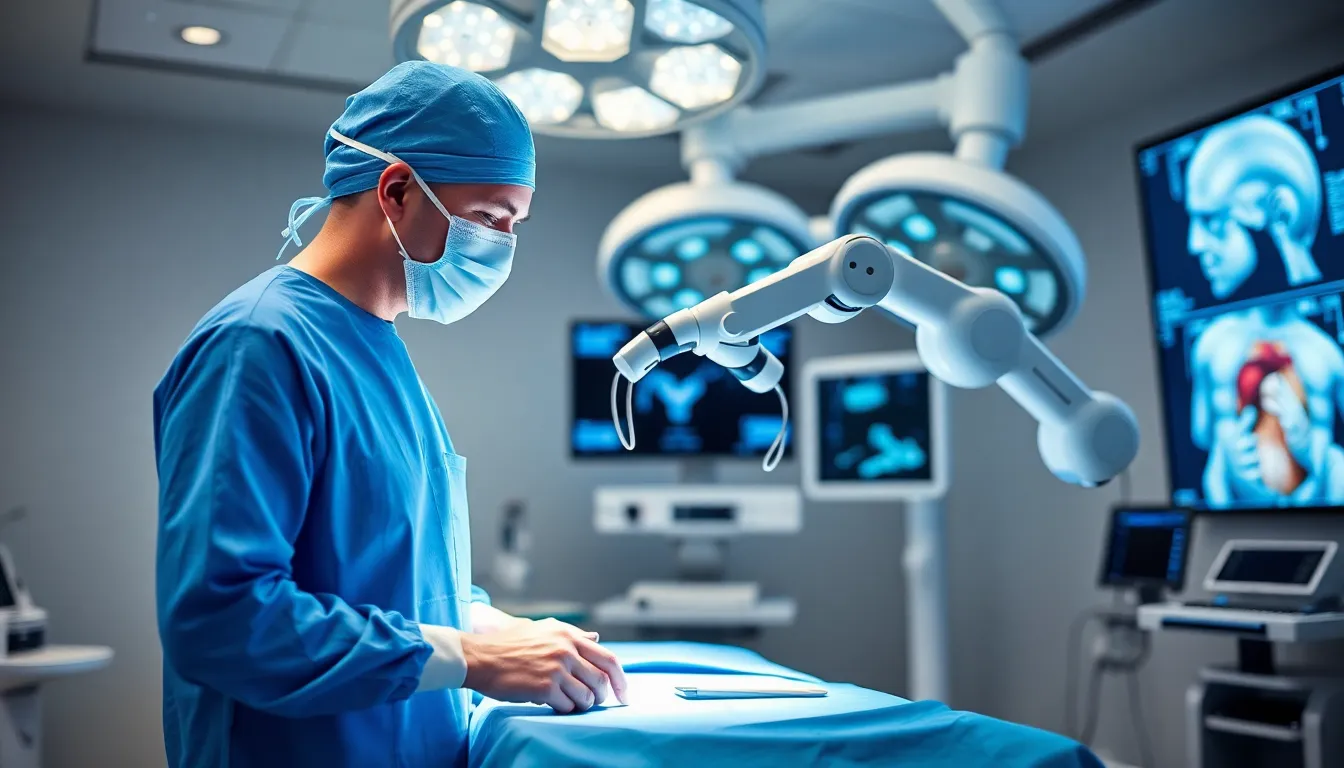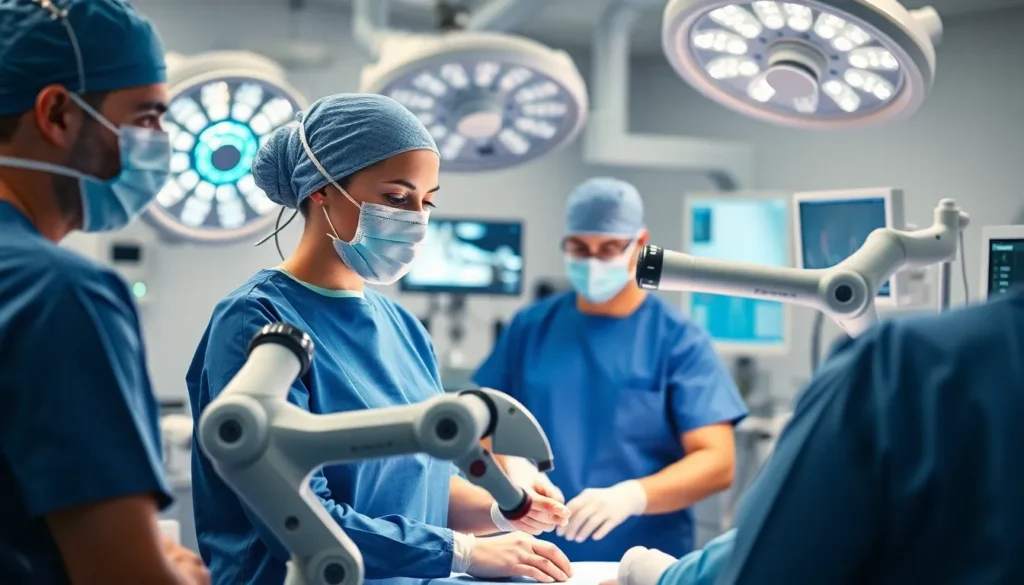Table of Contents
ToggleImagine a world where surgeons wield robots like expert puppeteers, performing intricate procedures with precision that would make even a Swiss watch jealous. Welcome to the realm of robotic surgery, where technology meets medicine in a dazzling dance of innovation. Gone are the days of massive incisions and lengthy recoveries; today’s robots are here to save the day—armed with tiny tools and a whole lot of skill.
These high-tech marvels don’t just assist; they elevate surgical practices to a whole new level. With enhanced accuracy and reduced risk, robotic surgery is revolutionizing how surgeries are performed. So, if you thought robots were just for sci-fi movies, think again. They’re here, and they’re ready to help doctors operate while you kick back and binge your favorite show. Dive into the fascinating world of robotic surgery and discover how it’s reshaping the future of healthcare.
Overview of Robotic Surgery
Robotic surgery represents a significant advancement in medical technology, enhancing traditional surgical methods through increased precision and efficiency. Surgeons utilize robotic systems for various procedures, benefitting from improved visualization and the ability to perform complex tasks with remarkable accuracy.
Definition and Purpose
Robotic surgery involves the use of robotic systems to assist surgeons during operations. This technology allows for minimally invasive procedures, often resulting in smaller incisions, reduced blood loss, and quicker recovery times. It enhances the surgeon’s capabilities by providing better dexterity and flexibility than the human hand. Surgeons can control robotic instruments with precision, translating their movements into smaller actions at the surgical site. This technology aims to improve surgical outcomes and patient safety, making surgeries less traumatic.
Historical Development
The journey of robotic surgery began in the 1980s with the introduction of the first robotic surgical system, known as the Puma 560. This system laid the groundwork for future innovations. In the 1990s, the da Vinci Surgical System emerged, bringing widespread use of robotic surgery in urology and gynecology. Surgeons embraced this system for its advantages in minimally invasive techniques. By 2000, the FDA approved the da Vinci platform for various surgical applications, leading to a surge in its adoption. Over the years, advancements in robotics, imaging, and computer technology have propelled the field forward, continuously enhancing the precision and effectiveness of robotic surgery.
Advantages of Robotic Surgery

Robotic surgery offers multiple advantages that enhance patient outcomes and surgical precision.
Precision and Accuracy
Robotic systems provide exceptional precision during surgical procedures. Surgeons can perform complex movements with enhanced control, enabling them to navigate intricate anatomy. Enhanced imaging allows for better visualization, ensuring that surgeons make accurate incisions. Less than a few millimeters of error can be critical, and robotic systems minimize this risk. Studies indicate that robotic-assisted surgeries often result in fewer complications and improved long-term outcomes. Precise movements reduce the likelihood of damage to surrounding tissues, further benefiting patient safety.
Minimally Invasive Techniques
Minimally invasive techniques define robotic surgery and significantly improve recovery times. Smaller incisions result in less trauma to the body, decreasing overall blood loss. Patients regularly experience reduced pain and scarring compared to conventional surgery. Quick recovery often leads to shorter hospital stays, allowing individuals to return to daily activities faster. As a result, the overall healthcare costs for robotic surgeries tend to be lower due to fewer complications. Surgeons frequently utilize robotic assistance to enhance their ability to perform delicate procedures with minimal disruption.
Applications of Robotic Surgery
Robotic surgery finds applications across various medical fields, enhancing surgical precision and improving patient outcomes. Its versatility continues to expand, addressing complex conditions through minimally invasive techniques.
Common Procedures
Common procedures utilizing robotic surgery include prostatectomies, hysterectomies, and cardiac valve repairs. Surgeons frequently perform robotic-assisted prostatectomies to treat prostate cancer, resulting in reduced blood loss and faster recovery. Hysterectomies for gynecological issues benefit from robotic systems, allowing for more precise tissue handling. Additionally, cardiac valve repairs utilize robotic assistance to minimize surgical trauma, which contributes to quicker patient recovery times.
Emerging Uses
Emerging uses of robotic surgery present exciting advancements in treatment options. Innovations include applications in orthopedic surgeries, such as joint replacements, where robotic systems enhance positioning accuracy. Gastrointestinal surgeries are also increasingly adopting robotic techniques, improving outcomes in procedures like gastric resections. Furthermore, surgical oncology shows promise with robotic systems aiding in complex tumor removals, enhancing visibility and precision.
Challenges and Limitations
Robotic surgery presents notable challenges and limitations despite its advancements.
Costs and Accessibility
Robotic surgery involves significant costs. High initial investments in robotic systems can limit their availability in hospitals. Ongoing maintenance expenses add to the financial burden. Some facilities might not afford these prices, restricting access to this technology. Additionally, patient insurance coverage varies, affecting affordability. Many patients face out-of-pocket expenses for procedures using robotic systems. Geographical disparities exist, with urban areas having more access than rural ones. Limited availability can create inequalities in healthcare services, hindering patient treatment options.
Technical Malfunctions
Technical malfunctions can arise during robotic surgeries. Equipment failures, though infrequent, can complicate procedures, causing delays. Surgeons rely heavily on these systems, meaning any malfunction directly impacts surgical outcomes. Backup systems are essential, yet not all facilities invest in such precautions. Training also plays a crucial role; insufficiently trained staff can exacerbate these issues. Malfunctions create reliance on manual methods, potentially increasing risks during critical moments. Continuous monitoring and maintenance are vital to prevent these occurrences. As robotic surgery evolves, addressing these technical challenges remains essential for enhancing patient safety.
Future of Robotic Surgery
Innovations in robotic surgery promise transformative changes in medical practices and patient outcomes. Emerging technologies continuously enhance surgical precision and effectiveness, reinforcing the trend toward minimally invasive procedures.
Innovations on the Horizon
New advancements in robotic systems enhance capabilities significantly. Companies are developing more compact designs to increase flexibility in tight surgical spaces. Artificial intelligence integration allows for real-time data analysis during surgeries, improving decision-making processes. Robotics research focuses on soft robotics, which can navigate delicate tissues with reduced trauma. Enhanced haptic feedback systems enable surgeons to feel and manipulate tissues more naturally. Continuous enhancements in imaging technology provide surgeons with clearer views, further elevating precision during complex procedures.
Potential Impact on Healthcare
Future developments in robotic surgery could reshape access to care and patient outcomes. As technology becomes more affordable, hospitals might adopt robotic systems more widely, decreasing healthcare disparities. Minimally invasive techniques lead to reduced recovery times and shorter hospital stays, ultimately lowering healthcare costs over time. Better surgical outcomes may also result in fewer post-operative complications, which benefits both patients and healthcare providers. Expanding robotic applications across various specialties promises to revolutionize treatment options, enhancing overall patient safety and quality of care.
Robotic surgery represents a significant leap forward in medical technology. With its ability to enhance precision and reduce recovery times, it’s transforming the surgical landscape. As advancements continue to emerge, the potential for this technology to improve patient outcomes is immense.
While challenges such as costs and technical risks remain, ongoing innovations promise to make robotic surgery more accessible and effective. The future looks bright as healthcare providers explore new applications across various specialties. This evolution not only aims to improve surgical techniques but also strives to elevate the overall quality of care for patients everywhere.




